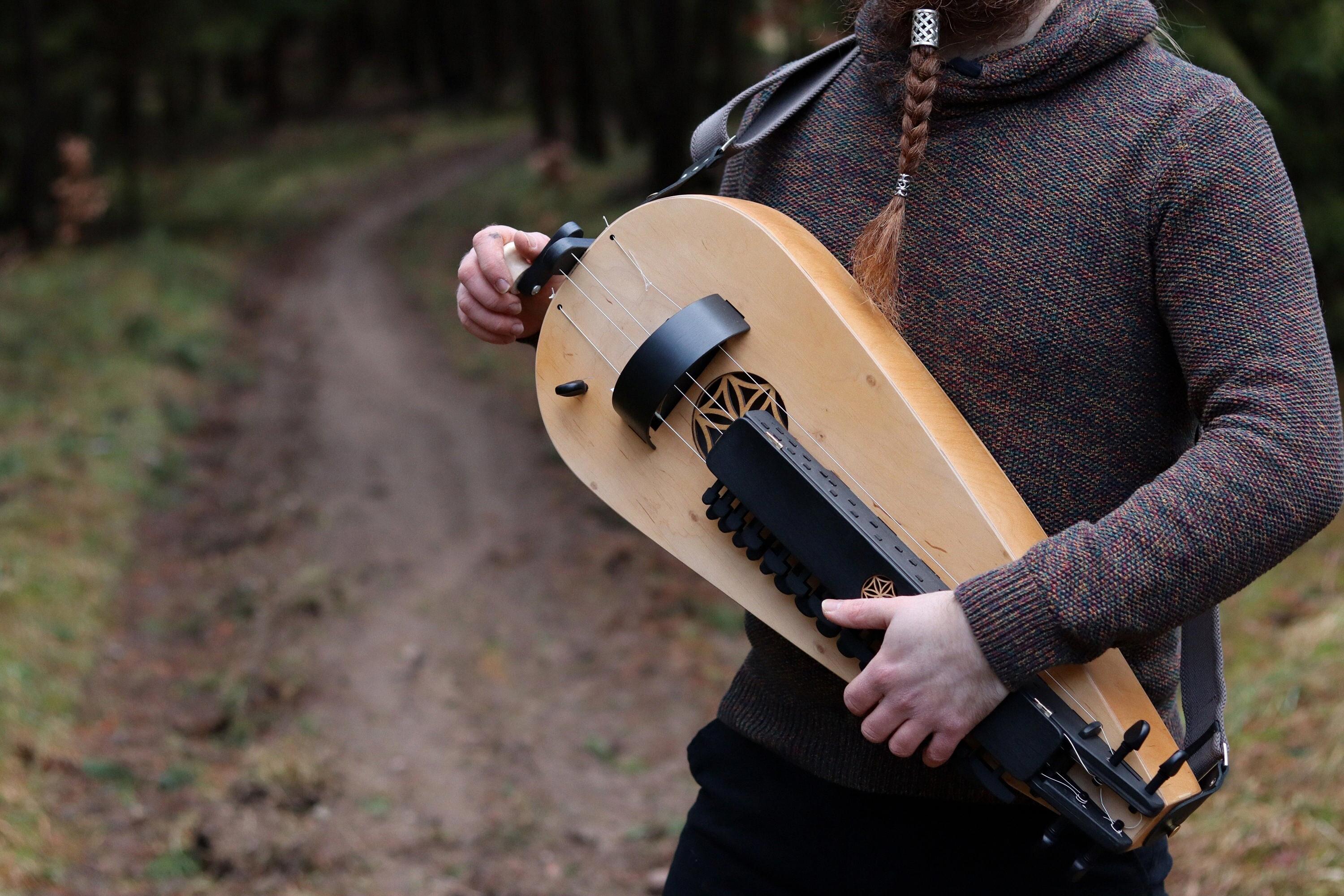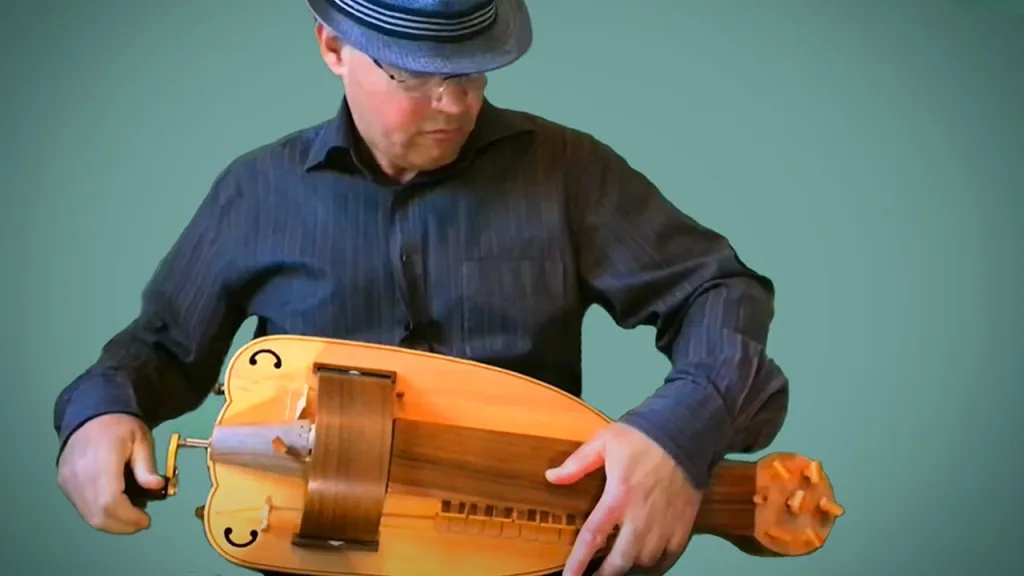The zanfona, also known as the hurdy gurdy, is a fascinating and unique musical instrument that has a rich history. Originating in Europe, it gained popularity in America during the 1800s. In Spain, it is commonly referred to as zanfona, derived from the Latin name ‘symphonia’.
The zanfona typically has a guitar-shaped body and is equipped with three melody strings and two drone strings. Some older models featured a diatonic keyboard, while most modern ones have a chromatic keyboard. This allows for a wider range of musical notes to be played.
When it comes to tuning, zanfonas are usually set to the key of C major, with the melody strings tuned in unison to G, just above the middle C on a piano. This tuning provides a harmonious and melodic sound that is pleasing to the ear.
The unique aspect of the hurdy gurdy is its method of producing sound. A hand crank-turned, rosined wheel is used to rub against the strings, creating vibrations that resonate and produce the desired notes. This mechanism gives the instrument a distinctive and captivating sound that is unlike any other.
In the 1860s, during the heyday of the American gold rush, there were even girls known as “hurdy girls” or “hurdies” who worked as dancing partners for prospectors in the town of Breckenridge. These girls would entertain in halls where one side was occupied by a bar and the other side featured a dance floor. The term “hurdy” was derived from the instrument itself, as it was often played during these lively events.
The zanfona has a long and storied history, and its unique sound continues to captivate audiences to this day. Whether you are a music enthusiast or simply curious about different instruments, the zanfona is worth exploring. Its melodic tones and historical significance make it a truly remarkable instrument.
The zanfona, or hurdy gurdy, is a captivating musical instrument with a rich history. Its guitar-shaped body, melody strings, and drone strings create a harmonious sound that is pleasing to the ear. The hand crank-turned, rosined wheel is used to produce the instrument’s unique and distinctive sound. Whether you are a musician or simply appreciate the beauty of music, the zanfona is a fascinating instrument worth discovering.
Is A Zanfona A Hurdy-gurdy?
A zanfona is indeed a hurdy-gurdy. The term “zanfona” is the most commonly used name for the hurdy-gurdy in Spanish. It is derived from the Latin word “symphonia”, which was another name for this musical instrument in ancient times.
To provide more clarity, here are some key points to consider:
1. Definition: The hurdy-gurdy is a stringed musical instrument that is played by turning a crank, which causes a rosined wheel to rub against the strings, producing sound.
2. Synonyms: Apart from zanfona, the hurdy-gurdy is known by various names in different languages. For example, it is called “vielle à roue” in French, “drehleier” in German, and “giraffa” in Italian.
3. Similarities: The zanfona and other variations of the hurdy-gurdy share common characteristics. They all have a crank, strings, a wheel, and keys or buttons to control the pitch of the notes.
4. Regional variations: While the basic design remains the same, there can be some regional differences in the construction and playing technique of the hurdy-gurdy. These variations may influence the sound and appearance of the instrument.
5. Historical significance: The hurdy-gurdy has a long history, dating back to medieval times. It was widely used in Europe during the Renaissance and Baroque periods, and its popularity continues to this day among folk musicians and enthusiasts of historical music.
The zanfona is a specific name for the hurdy-gurdy in Spanish, which is a stringed musical instrument played by turning a crank. Its origins can be traced back to ancient times, and it has been known by various names in different languages throughout history.

Where Is The Zanfona From?
The Zanfona, also known as the Spanish hurdy-gurdy, originates from Spain. It is a traditional musical instrument that is commonly found in Spanish folk music. The body of the Zanfona is typically guitar-shaped, with three melody strings and two drone strings.
In older versions of the Zanfona, there was a diatonic keyboard, but most modern models now feature a chromatic keyboard. The instrument is usually tuned to the key of C major, with the melody strings tuned in unison to G above middle C on the piano.
The Zanfona is an integral part of Spanish musical culture and has been played for centuries. Its unique sound and distinctive design make it a fascinating instrument to study and listen to.
What Is A Hurdy-gurdy Called?
A hurdy-gurdy, also known as a wheel fiddle or a wheel vielle, is a type of stringed instrument. It gets its name from the sound-producing mechanism used to create music. The instrument features a hand crank-turned, rosined wheel that rubs against the strings, causing them to vibrate and produce sound. This unique mechanism sets the hurdy-gurdy apart from other string instruments like guitars or violins, which are played by plucking or bowing the strings directly. The term “hurdy-gurdy” is the most commonly used name for this instrument, but it is also referred to as a wheel fiddle or wheel vielle, reflecting its method of sound production.
What Is A Hurdy-gurdy Girl?
A hurdy-gurdy girl, also known as a hurdy girl or a hurdies, refers to the girls who worked as dancing partners for prospectors in the town of Breckenridge during the 1860s. This term originated in Europe, but became popular in America during the 19th century.
These girls were employed in halls that were divided into two sections. On one side, there was a bar where patrons could enjoy drinks and socialize. On the other side, there was a dance floor where the hurdy-gurdy girls would dance with the prospectors.
The term “hurdy-gurdy” is actually derived from a musical instrument that was popular in Europe. The hurdy-gurdy is a stringed instrument that produces sound by a crank-turned wheel rubbing against strings, similar to a violin. However, in the context of the hurdy-gurdy girls, the term does not refer to the instrument itself, but rather to the girls who worked in these halls.
These girls played the role of dancing partners for the prospectors, providing entertainment and companionship. They would dance with the prospectors, engaging in lively and energetic dances to keep the atmosphere lively and enjoyable. The hurdy-gurdy girls were an integral part of the social scene in the mining towns during this time period.
A hurdy-gurdy girl was a dancing partner for prospectors in the 1860s Breckenridge. They worked in halls where a bar was on one side and a dance floor on the other. The term “hurdy-gurdy” is derived from a musical instrument, but in this context, it refers to the girls themselves, not the instrument.

Conclusion
The zanfona, also known as the hurdy gurdy, is a fascinating stringed instrument with a rich history. Its name in Spanish, ‘zanfona’, is derived from the Latin word ‘symphonia’, highlighting its importance in ancient music. The zanfona typically features a guitar-shaped body with three melody strings and two drone strings. While older models had a diatonic keyboard, modern versions often come with a chromatic keyboard.
The tuning of the zanfona is usually in the key of C major, with the melody strings tuned in unison to G above middle C on the piano. This unique tuning produces a distinct and enchanting sound that sets the instrument apart from others. The zanfona’s sound is created by a hand crank-turned, rosined wheel rubbing against the strings, resulting in a melodic and resonant tone.
The zanfona’s popularity has persisted over time, and it has been enjoyed by musicians and enthusiasts around the world. Its versatility allows for a wide range of musical expressions, making it suitable for different genres and styles. The instrument’s historical significance and cultural value make it a cherished part of musical traditions.
The zanfona, or hurdy gurdy, is a captivating instrument with a unique sound and a rich cultural heritage. Its distinct features, such as the hand crank and rosined wheel, contribute to its captivating and melodic tones. Whether used in traditional or contemporary music, the zanfona continues to captivate audiences and serve as a testament to the ingenuity and creativity of musicians throughout history.
